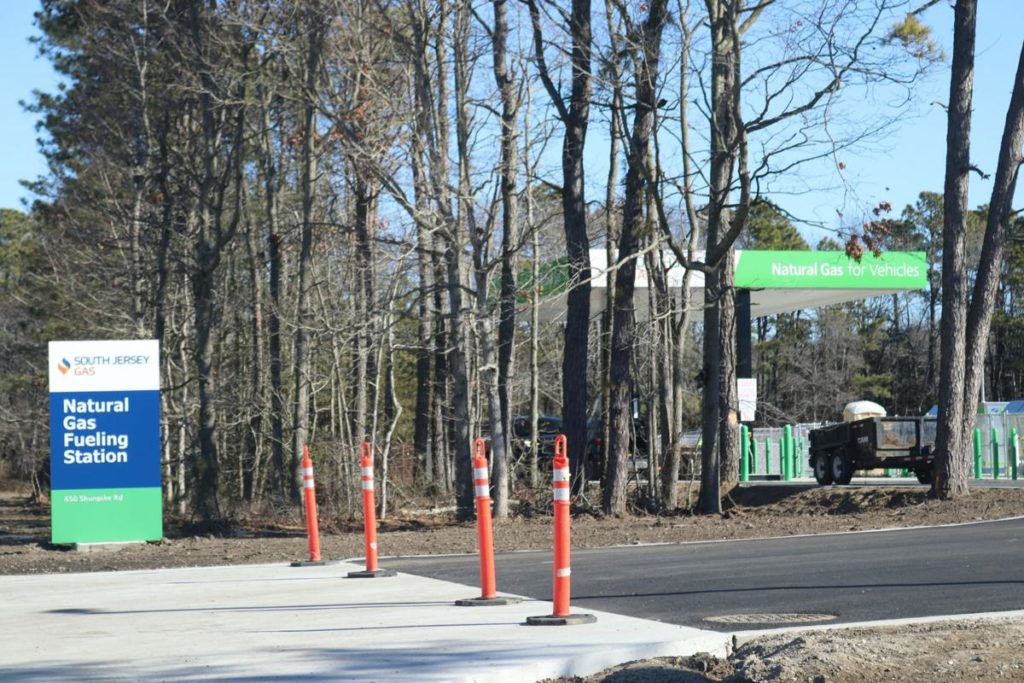
BURLEIGH – The Cape May County Municipal Utilities Authority Transfer Station, on Shunpike Road, is less than half a mile from the Garden State Parkway and close to the businesses along North Wildwood Boulevard; but set amid dense trees, it’s in a world of its own.
The site is a relay station for municipal waste programs from the county’s southern portion, a place where materials can be dropped off for collection by MUA trucks for transfer 14 miles to the sanitary landfill, on the border between Woodbine and Upper Township.
This year, some of those transfer trucks will be powered by compressed natural gas, and the natural gas utility, South Jersey Gas, has installed a fueling station next to the property.
Like Other Filling Stations
The station will operate like other gas stations, open to anyone who pulls in if their vehicle runs on compressed natural gas.
“Anyone who has a CNG-fueled vehicle can use the site. The main users will be our SJG fleet and the Jitney during the summer season,” said Casey Shea, a spokeswoman for South Jersey Industries. “There are instructions at the facility to show any user how to operate the system. A driver with a debit or credit card can fuel at the location.”
MUA Executive Director Joseph Rizzuto said the authority has plans to purchase compressed natural gas trucks to make the trip between the Burleigh transfer station and the landfill.
In Atlantic County, where the MUA also handles household collection, that authority began moving its collection fleet to compressed natural gas in 2010.
Grants will help fund the purchase of the new vehicles, Rizzuto said.
By the Numbers
According to the U.S. Department of Energy, there are 175,000 natural gas-powered vehicles in the United States and about 23 million worldwide.
In comparison, as of 2018, there were a million electric vehicles in use around the country, and both numbers are dwarfed by the number of gasoline-powered cars. There are about 250 million vehicles in the country, and most are some variation of the gasoline engine invented in the 19th century, or the diesel engine from early in the 20th.
Gas Advantages
South Jersey Gas touts advantages in the use of compressed natural gas, both in a reduction in carbon emissions and reduced fuel costs.
According to data released by the agency, 41% of greenhouse gas emissions are released by the transportation sector, and while heavy duty vehicles make up only 1% of vehicles on the road, they release close to 20% of those emissions.
Natural gas power can present issues for long-distance transportation, according to the alternative fuels data center presented by the Department of Energy. Fuel sources can become scarce in some areas, but the fuel can be a good match for high mileage, centrally fueled fleets.
That seems to describe the MUA vehicles that travel in a loop between the transfer station and the landfill.
The data center report states that the horsepower, acceleration and cruising speed of natural gas vehicles are similar to those of gasoline-powered counterparts. Natural gas has been used to power vehicles since the 1930s, according to the publication Consumer Reports, which reported in 2014 that after a decline in the market, more companies were releasing natural gas-powered vehicles.
A 2017 report, in Auto Week, points out that the alternative fuel seems more attractive when oil prices are through the roof, but may seem less alluring when prices plummet and the infrastructure are already in place for diesel.
Meanwhile, far more research and development is looking at electric vehicles, with options ranging from the Tesla to the Nissan Leaf.
Not All Agree
At the same time, not everyone agrees that natural gas is an ecological choice. The Sierra Club has charged that the fuel continues to emit greenhouse gases; even it amounts to less than a similar diesel engine.
It’s the method of extraction that draws most of the group’s ire. Hydraulic fracturing, known as “fracking,” involves the injection of water and chemicals underground, creating fractures in rock that release natural gas.
The technique has driven down energy costs and made the United States a fuel exporter, fueling a decade-long gas boom.
Opponents, including the Sierra Club and other environmental advocates, point to problems with fracking, including contamination to groundwater and other pollution, even the potential triggering of earthquakes.
“The production, processing, storage, transmission and distribution of fracked gas leaks immense amounts of a dangerous greenhouse gas into our atmosphere,” reads a Sierra Club report.
To contact Bill Barlow, email bbarlow@cmcherald.com.
